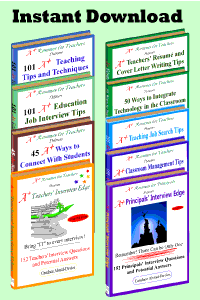There’s no escaping the influence of social media in today’s job search process. Sites like LinkedIn, Twitter, and Facebook have become the new tools for schools and principals looking for their next hire.
LinkedIn has grown to become the world’s largest professional network. It makes sense to have your presence on it, to greatly enhance your chances of getting noticed even without applying for a teaching job!
Here are tips for creating your LinkedIn profile and embracing the benefits of being active on this professional network. Alternatively, if you already have one, you can learn a few tricks to attract attention from the right people and get noticed.
Don’t underestimate the power of using social media networking strategies to find job leads and enhance your career.
Tips to Write a LinkedIn Profile and Network
1. Professional LinkedIn Profile Picture
LinkedIn is for professionals, and anything other than that is best left for Facebook. If you are unsure whether the picture you took on your last vacation fits the bill, it is time to invest in a professional photo. A clear, up-close headshot in your best formal attire should do the trick.
2. Catchy and Keyword Rich Headline
Your tagline or headline does not have to be just your current job title or last-held position. Instead, be creative and develop a few words that best describe you, keeping your target education job titles in mind. Look at other teaching profiles and examine how the best ones set themselves apart, with an attention-grabbing tagline, including their job title.
3. Include Geographic Location
Enter your target teaching job location, as that is one of the criteria schools use to find you. If you are willing to relocate, make sure, you mention it prominently.
4. Short LinkedIn Summary – Your Story
Your summary needs to highlight your story – your strengths, passions, career highlights, and breadth and depth of experience in various teaching capacities or domains. The character restriction is 2000. To catch the reader’s attention, pen it in the first person. In a couple of sentences, you could also mention how/why you chose to become a teacher or made a transition to education. However, make sure it is not too lengthy – ideally, limit it to about 3-5 short paragraphs.
Note: Don’t forget to include your short-term and/or long-term goals in this section. If a prospective employer is unable to figure out what you want to do next, there is every chance you might get passed on.
5. Sprinkle Keywords Throughout Your LinkedIn Profile
Research the relevant education keywords in your target teaching job descriptions, and mention them through your entire profile, including the summary. These words are what schools or principals use to find educators like you.
6. Make it an All-Star LinkedIn Profile
LinkedIn gives you a score of the completeness of your profile. Score a 100% on this, as an incomplete profile reduces the chances of your profile popping up in search results. Take the time to fill in all sections of your profile – LinkedIn shows what sections you need to fill to make it All-Star.
7. Quantify Achievements, Like Your Resume
Uncover and communicate relevant achievements to add creditably. Use numbers to highlight accomplishments, whenever possible, just like in your resume. Whether they are your career highlights in the summary of achievements in individual roles, using numbers gives the reader a context and enhances your credibility.
8. Problem-Action-Results Approach
Just like in your resume, adopt a problem-solver and achievement-based approach. Highlight a problem that you solved with your actions and the impact it had on the school.
9. Get Creative with Your Message
Try to avoid overused phrases like hard-working, punctual, detail-oriented, organized, etc. Instead, write about instances in which these qualities of yours helped you improve a situation or overcome a challenge. Merely mentioning a quality without a story to back it up comes across as lame.
10. List Your Current Position
If you are currently unemployed, between jobs, or trying to make a comeback, do not leave the current position blank. Instead, list your target job title, along with maybe a sentence about ‘seeking new opportunities’ or ‘making a transition….’
11. Display Your Work
If you link to a past project or work that you are proud of, showcase it by uploading it in the Summary section or under individual job descriptions. You can also include it under the Projects section.
12. Publications, Volunteer Work, Certifications, Languages, Honors/Awards
Include any relevant volunteer work to show off additional teaching-related skills that you did not have a chance to showcase as part of your regular teaching job. If you have any papers presented at conferences or published in journals or websites, mention these too. Awards, honors, relevant certifications, and proficiency in foreign languages are all worthy of mention on your LinkedIn profile.
13. Skills and Endorsements
Display your strengths and skills most relevant to education and your specific teaching area. You can also use your target keywords to populate this field. Request your network connections to endorse your skills.
14. Request Recommendations
Recommendations from your connections add credibility to your work and validate your accomplishments. They are genuine and highlight specific qualities that are not found on your resume (where achievements are sometimes puffed up). When you request a recommendation, you could also specify a quality or skill you want to recommend.
15. Write/Share Posts or Updates
If you have something relevant and interesting about your teaching career that you want to share, do it! Better still, write a post on the publisher’s platform. It shows your interest and engagement in the teaching industry and the fact that you make an effort to stay on top of new educational information and trends, which many schools and principals look for in a job candidate.
16. Comment on Other’s Posts
Commenting on other people’s posts is another way of showcasing your industry knowledge – this goes beyond just clicking ‘like’ on someone’s post. Adding a thoughtful comment or offering your insights are good ways to show off your expertise in teaching.
17. Join Groups
Join groups relevant to education – keep yourself abreast of what is happening in the education industry, get in touch with like-minded individuals, and be part of discussions, which is another way to get noticed.
18. Grow Your LinkedIn Network
The more connections you have, the better odds of finding a person in your target school or district through whom you could get your foot in the door. However, merely adding connections to your network will not be of much help. Make a professional effort to reach out and get to know them on a personal level.
19. Customize Your LinkedIn Profile URL
LinkedIn provides a default URL, which contains a string of characters and numbers. Personalize your profile URL by going to ‘Edit Public Profile URL’ under Settings.
20. Include Contact Information
Including your email id will help people get in touch with you if they are not in your network. If you are active on Twitter or blog frequently, include links to those as well.
21. Reach Out Directly to Hiring Managers
For instance, if you target an Elementary Teacher’s position, you can search LinkedIn for the principals of certain schools you are interested in and send them an InMail. (InMails can be directed to individuals who are not in your network, only if you have a Premium subscription.)
Alternatively, you could use sites like Voila Norbert, FindAnyEmail, or download Chrome extensions like Hunter to find their email addresses. Reaching out directly via email is a great way to establish and build a genuine relationship.
22. Finally, Know Your Settings
If you are updating your profile and adding principals and superintendents to your network, chances are you do not want your current employer to know. View and change your Profile Settings to keep your job search process discreet, if necessary.
Whether you want others to see your profile updates, know who viewed your profile, or find out whether your connections are visible are all things you can control.
Although your LinkedIn profile is so important to your professional brand, it can be tough to write it yourself.
Most people find it hard to boast about themselves, and, additionally, it can be hard to find the time or motivation to complete it!
However, if you fail to complete your LinkedIn profile, you will be missing out on networking and teaching opportunities.
So, it’s time to transform your underperforming LinkedIn profile into a POWERFUL career tool that highlights your teaching skills, experiences and impresses and grows your professional network.
The good news is that I’m here to help! With our professional LinkedIn profile development service, I will work directly with you to develop a unique LinkedIn profile to build your brand, grow your network, and impress potential employers.
At A+ Resumes for Teachers, we pride ourselves on providing you with a LinkedIn profile that effectively represents your professional brand online. We know how to help you connect with your target audience.
Feel free to contact me (Candace) personally by email or phone to learn more about our LinkedIn development or ask any questions.
Toll-free: 1-877-738-8052
International / Local: (780) 513-0010
Email: candoco@telus.net


